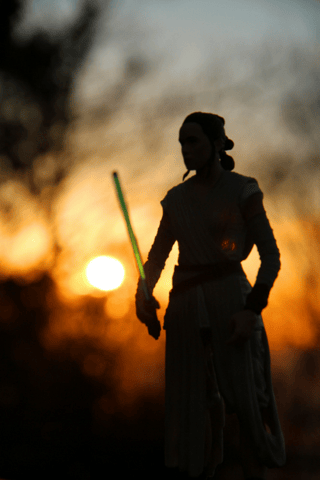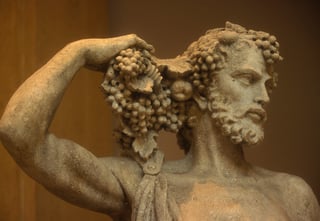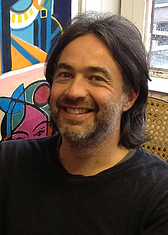A guest post by Keiron Le Grice
Although Star Wars: The Force Awakens broke box-office records for commercial success, we might lament the filmmakers’ missed opportunity to deliver a narrative of enduring mythic significance and philosophical profundity to its expectant global audience. Had this opportunity been taken, how—in an alternate galaxy far, far away—might the storyline have begun and been developed?

We can look to familiar sources for guidance. Mythologist Joseph Campbell’s influence on George Lucas is well documented: it is especially evident in the original trilogy’s portrayal of prominent elements of the hero myth. Campbell, in turn, was significantly shaped by the work of Swiss psychiatrist Carl Gustav Jung. Campbell saw in the Star Wars films a modern retelling of the perennial themes of the hero’s journey, populated with Jungian archetypal figures and mythic motifs, such as the battle of good and evil, the call to adventure, the Wise Old Man, and the quest to find the father—themes and adventures re-enacted almost to caricature in the latest installment. Beyond this, however, both thinkers were acutely attuned to the “spiritual problem of modern man,” as Jung put it, in the form of a crisis facing individuals in a secular age characterized by the loss of myth and the experience of existential meaninglessness[1]. Exploring such matters and drawing on other insights from Jungian psychology, the filmmakers might have developed the modern myth of Star Wars to speak to the pressing problems of our time.
With the presumed death of Palpatine and the redemption of Darth Vader at the end of The Return of the Jedi, the only remaining disciples of the dark side of the Force seemed to have been vanquished. We might imagine, then, that a period of universal harmony would have ensued, with the light side of the Force reigning unopposed. In such a scenario, how might the absence of the dark side have been addressed in the new film? What would be its consequences?
The entire drama of Star Wars, like the drama of life, is predicated on the existence of the dark side as an absolutely necessary counterpart to the good. Light cannot exist without dark, good would not be recognized without an awareness of evil, to know peace we must have known war—Heraclitus’s insight into the dynamic relationship of opposites impressed itself on Jung, as it did on Friedrich Nietzsche before him. As Jung realized, it is only out of the tension of opposites, from the suffering and struggle created by the dark power of the Satan/Lucifer principle, that consciousness is born. The name Lucifer, Jung pointed out, means “the bringer of light.”[2]
Needless to say, without the intervention of the dark side, none of the adventures witnessed in the first two trilogies would have taken place. The heroism of Luke Skywalker and his companions would not have been called forth. Jungian psychology tells us that the dark side of human nature—the Shadow—is not only the source of evil but of the instinctual power and dynamism that give to life a vitality and authenticity it would otherwise lack. Without the imminent threat of the dark side, and the inherent tension it provides, it is entirely possible, then, that a period of spiritual and creative stagnation would set in, suggested by the mythic motif of a kingdom asleep, with its people wholly absorbed in the comforts and pleasures of life.
We might imagine further that the population, in its dull happiness, might come to forget the Force entirely, and fall into ignorance. Even the spiritually inclined Jedi might not be immune to the decay. As seems to happen to many religions, a literal rendering of its teachings might become an unquestioned orthodoxy, even empty dogma, such that the living connection to the Force (or whatever name is given to spirit) becomes all but lost, as happened, in the view of Jung and Campbell, to Christianity in the modern era. We can imagine that young Padawans, Jedis in training, would themselves be excessively bound by this dogma, inhibited by the great history that had gone before them and by the time-honored rules of the Jedi order, seeking only to emulate Skywalker or Yoda rather than growing into their own spiritual authenticity. In a variant of the imitatio Christi, the aspiration to imitate the ways of Jesus, such imitation would fail to deliver genuine spiritual realization or promote psychological growth (individuation, to use Jung’s term). If not succumbing to dogma and imitation, it is also conceivable that spiritual practice might become excessively concerned with mystical transcendence, removed from the messy complexity of the immanent reality of the world—a critique raised by James Hillman.
In its neglect of the material realm, as the example of the Christianized West suggests, an otherworldly spirituality might in turn bring forth crude materialism and hedonism—its polar opposite. Without the necessary outlet for heroism and spirituality, the culture would in time inevitably fall into decadence, frivolity, barbarism, and ruin, as happened to ancient Rome, and as we see increasingly in our own time. With no genuine life adventure to be lived, people might fall prey to atavistic yearnings or indulge in the fabricated adventures offered by consumerist society.
With this kind of situation as an alternative context and background for the new Star Wars, the film’s hero would then perforce be the one who upsets the status quo, who breaks free of the old myths of Jedis long ago, in search of new, authentic experience. The hero would, in this scenario, need to overcome the patterns of archetypal repetition, breaking the “eternal return” of the same themes and stories, playing out over and over again in similar ways in different historical periods—a repetition all too evident in and perpetuated by The Force Awakens.
Crucially, perhaps the hero would need to embrace rather than conquer the dark side, and retrieve from the Shadow the passion and power necessary for the reinvigoration of the galactic civilization. What intriguing and compelling viewing it would be to explore the integration of the light and dark, good and evil, within a single individual. Rather than the projection of the dark power of the Shadow onto overt enemies, such as Darth Vader and Palpatine, as before, the latest film could have explored how the dark side could be faced and assimilated by a hero able to go beyond facile distinctions between good and evil. With this integration, we would have to see a new kind of Jedi emerge, perhaps one not unlike Nietzsche’s vision of the Übermensch, the Overman, or suggested by Jung’s notion of the Self as the universal “great man.” This new Jedi would leave behind outmoded spiritual ideals and second-hand religious truths, going beyond moral conceptions of what is conventionally understood as “good,” to assimilate the long-repressed power of the instincts, the body, and the earth.
In remaining wholly on the side of the good, it could be said that Jedis fail to come to terms with the primitive, uncivilized emotional and instinctual energy of the dark side. The implication is that Jedis have overcome such emotions, but only through attaining a condition of detachment and equanimity by which they are able to resist the lure of the lower nature. In this state of seemingly imperious detachment, however, the dark side remains unredeemed, and the denied Shadow energy that has no place in the life of the Jedi then manifests destructively through the evil deeds of those with the misfortune, or the courage, to embrace the darkness. The Jedi attains supreme spiritual mastery and purity. But the Jungian Self represents wholeness rather than spiritual perfection. It is a wholeness that is only possible when the dark side has been integrated into conscious experience.
 There is no place in the Jedi experience for the complex of qualities suggested by the mythic figure of Dionysus. As the archetype of “unbridled and unbroken Nature,”[3] Jung describes Dionysus as “the abyss of impassioned dissolution in the animal psyche,” an experience that can either obliterate or transform human consciousness.[4] Closely related to Dionysus is the archetypal-mythic figure of Wotan, god of storm and frenzy, and the alchemical god-man Mercurius, the spiritus vegetavius or chthonic power that, as the tail-eating serpent or dragon (the uroborus), consumes itself in its own transformative power.[5] The energies symbolized by such figures have no place in the Jedi experience or in the ordered life of civilization, and thus tend to manifest unconsciously and often destructively. As long as these qualities remain exclusively personified by the protagonists of the dark side, they cannot be integrated. Yet such energies provide the very instinctual power necessary to grow beyond an insipid spirituality of detachment and unruffled tranquility, and to redeem the wasteland of a culture out of touch with the animating wellsprings of life.
There is no place in the Jedi experience for the complex of qualities suggested by the mythic figure of Dionysus. As the archetype of “unbridled and unbroken Nature,”[3] Jung describes Dionysus as “the abyss of impassioned dissolution in the animal psyche,” an experience that can either obliterate or transform human consciousness.[4] Closely related to Dionysus is the archetypal-mythic figure of Wotan, god of storm and frenzy, and the alchemical god-man Mercurius, the spiritus vegetavius or chthonic power that, as the tail-eating serpent or dragon (the uroborus), consumes itself in its own transformative power.[5] The energies symbolized by such figures have no place in the Jedi experience or in the ordered life of civilization, and thus tend to manifest unconsciously and often destructively. As long as these qualities remain exclusively personified by the protagonists of the dark side, they cannot be integrated. Yet such energies provide the very instinctual power necessary to grow beyond an insipid spirituality of detachment and unruffled tranquility, and to redeem the wasteland of a culture out of touch with the animating wellsprings of life.
In periods of spiritual decay and creative stagnation, when the world has become stale, Jung believed that individuals, and cultures, must return to the source for rebirth and renewal. In myth, the source is often personified in the figure of the Great Mother, a symbol of the unconscious psyche as the matrix of all existence and source of the Dionysian archetype. In Jung’s view, the alienated individual, cut off from the waters of life, desires reunion with the Mother that he or she might drink again from the fountainhead of life and redeem the wasteland of the alienated state. The Star Wars films have thus far placed primary emphasis on the Father or the role of the Wise Old Man as mentor. But what of the archetypal Feminine and the Great Mother?
Whereas the archetypal Father is the “representative of the spirit,” differentiated into good and evil, and adjudicator of the law, the archetypal Mother represents primal life energy before any distinction into ethical categories.[6] The Mother embraces all life, just as nature cannot be said to be inherently good or evil. How might the film have depicted the Great Mother as source, as the very origin of the Force, and thus addressed the paradox that the dark side and the light side are mutually implicated expressions of a single energy? How, furthermore, might Star Wars have explored the realized unification of the two aspects of the Force?
These are complex considerations, of course. And while such a scenario would likely not be as readily assimilated by its audience as is the stock fare of action-adventure in The Force Awakens, this drama has relevance to the situation we face in our own time, confronting the unprecedented challenge of the ecological crisis. For it is arguably the unredeemed and integrated energy of the dark side—the human Shadow—that drives unconscious patterns of consumption and denial, and that causes us to ravage the earth and plunder natural resources as if they were inexhaustible. How valuable it would have been if the film, with its staggering global outreach, had explored the necessary integration of the chthonic, material, and instinctual into the spiritual ideal of the Jedi. The culture might then have awakened to the force of our collective Shadow.
Like many millions of others, I suspect, after watching The Force Awakens I left the cinema superficially entertained by a fast-paced action film rather than bearing witness to the shaping of a myth that would prove insightful and illuminating for our current world situation and moment of history. The opportunity remains, however, in the next two installments, to demonstrate that the franchise’s remarkable talent for merchandising can be matched by a skill for mythmaking.
[1] See, Jung, “The Spiritual Problem of Modern Man,” (1928/1931) in Civilization in Transition.
[2] See Jung, Mysterium Coniunctionis, 114
[3] Jung, Symbols of Transformation, 401.
[4] Jung, Psychology and Alchemy, 90.
[5] Jung, Mysterium Coniunctionis, 225.
[6] Jung, Symbols of Transformation, 261
Bibliography Jung, Carl Gustav. Mysterium Coniunctionis. Translated by R. F. C. Hull. Princeton, NJ: Princeton, 1989.
———. Psychology and Alchemy. Translated by R. F. C. Hull. Princeton, NJ: Princeton, 1993.
———. “The Spiritual Problem of Modern Man.” 1928/1931. In Civilization in Transition. 2nd edition. Volume 10 of The Collected Works of C. G. Jung. Translated by R. F. C. Hull. Princeton: Princeton University Press, 1989.
———. Symbols of Transformation. 2nd ed. 1967. Vol. 5 of The Collected Works of C. G. Jung. Translated by R. F. C. Hull. Repr., Princeton: Princeton University Press, 1976.
This article first appeared in the online Immanence Journal.
 Keiron Le Grice is a professor of depth psychology and chair of the Jungian and Archetypal Studies Specialization at Pacifica Graduate Institute, Santa Barbara, where he teaches courses on archetypes, alchemy, synchronicity, and the history of depth psychology. He was educated at the University of Leeds, England (B.A. honors, Philosophy and Psychology) and the California Institute of Integral Studies in San Francisco (M.A., Ph.D., Philosophy and Religion). Keiron is the founding editor of Archai: The Journal of Archetypal Cosmology, and the author of four books––The Archetypal Cosmos, Discovering Eris, The Rebirth of the Hero, and the recently published Archetypal Reflections: Insights and Ideas from Jungian Psychology. He has also taught for Grof Transpersonal Training (UK) and is commissioning editor for Muswell Hill Press in London.nd the Enneagram.
Keiron Le Grice is a professor of depth psychology and chair of the Jungian and Archetypal Studies Specialization at Pacifica Graduate Institute, Santa Barbara, where he teaches courses on archetypes, alchemy, synchronicity, and the history of depth psychology. He was educated at the University of Leeds, England (B.A. honors, Philosophy and Psychology) and the California Institute of Integral Studies in San Francisco (M.A., Ph.D., Philosophy and Religion). Keiron is the founding editor of Archai: The Journal of Archetypal Cosmology, and the author of four books––The Archetypal Cosmos, Discovering Eris, The Rebirth of the Hero, and the recently published Archetypal Reflections: Insights and Ideas from Jungian Psychology. He has also taught for Grof Transpersonal Training (UK) and is commissioning editor for Muswell Hill Press in London.nd the Enneagram.



